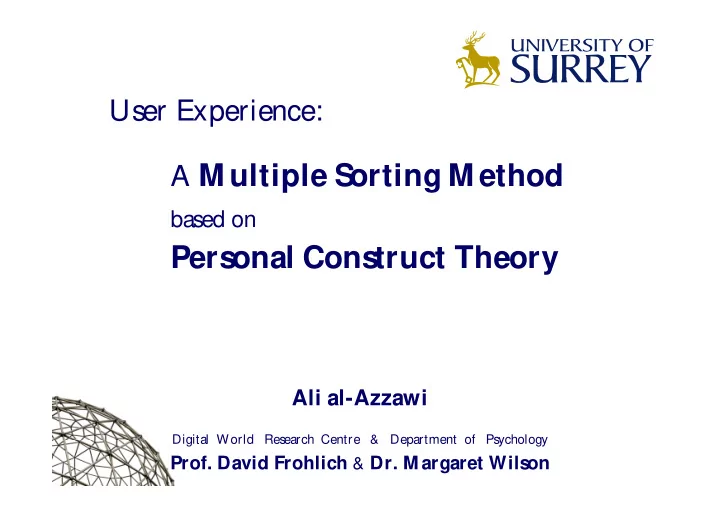

User Experience: A M ultiple S orting M ethod based on Pers onal Cons truct Theory Ali al-Azzawi Digital World Res earch Centre & Department of Psychology Prof. David Frohlich & Dr. M argaret Wils on
Overview • UX & PCT • The MSP Method • Results • Conclusion
Research Questions Generally : What does User Experience mean? Specifically : How do people perceive and experience media devices? What are the physical properties that underlie the perceptions?
PCT Approach The basic postulate of the Personal Construct Theory : “A person’s processes are psychologically channelized by the ways in which he anticipates events” (Kelly 1955) Approach User Experience as the result of interconnected constructs What are the constructs for digital devices?
The Method Multiple Sorting Procedure (MSP) + Compares a large number of stimuli simultaneously + Not essential, but useful to verbalise the constructs + No assumption of “polar” categories + No assumption of continuum within constructs + Rich data (quantitative, qualitative & graphical) + Quick and easy to conduct
Applying The Method MP3 players 35 Life-size photographs
The Script “…sort them into groups in such a way that all the MP3 players in each group are similar to each other in some important way and different from those in the other groups. You can have as many groups as you like, and have as many MP3 players in each group as you like. It is your views that count. When you have carried out the sorting I would like you to tell me the reasons for your sorting, and what the MP3 players in each group have in common.”
The Procedure Construct Category 1 Category 2 Category 3 Category 4 Category N For example: Screen : “large”, “horizontal”, “colour” …
Types of Sorts Type-1 Type-2 Type-3 Semi- Free Structured Structured Unlimited 1 1 No. of Sorts Unlimited Unlimited Fixed No. of Piles Unrestricted number of cards per pile
Constructs & Categories Type-1: Free Type-2: Semi-Structured 25 Constructs found 59 Categories found For example: For example: – Screen – Functional – Size – Original – Controls – Futuristic – Gender – Quirky – Convenience – Classic 7.4 sorts (constructs) per participant 4.1 piles (categories) per participant
MSA of First Sorts First impressions are based on shape
Type-3 Structured-Sort – Preference • One sort • Unrestricted number of cards per pile • 7 Point Preference Scale (7 numbered-piles) [Likert] (1 = least, 7= most)
Mean Item Preference 7.0 6.0 5.0 Mean Preference 4.0 3.0 2.0 1.0 20 21 23 26 9 1 19 5 16 22 28 30 3 12 13 18 10 4 14 35 11 15 2 27 25 24 31 8 6 7 17 29 33 34 32 MP3-player Code
Conclusions 1. Quick & Easy to Conduct a) Sorting types i. Free ii. Semi-Structured iii. Structured b) No verbalisation required c) No polarisation imposed 2. Rich Data a) Qualitative i. Constructs ii. Relationship of constructs iii. Graphical representation iv. Interview (ad-hoc & prepared) b) Quantitative (e.g. preference mean)
Thank You Ali al-Azzawi a.al-azzawi@surrey.ac.uk
Recommend
More recommend